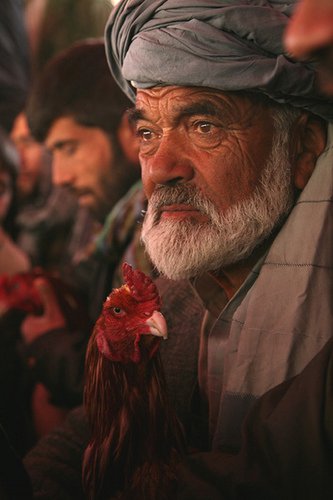|
The Sports of Cockfighting in Afghanistan became legal again after the Taliban were removed from power during the "war on terrorism". Afghanistan i/æfˈɡænɨstæn/ (Persian/Pashto: افغانستان, Afġānistān), officially the Islamic Republic of Afghanistan, is a landlocked country located in the centre of Asia, forming part of South Asia, Central Asia, and Greater Middle East, it is also considered to be part of a broader West Asia. With a population of about 29 million, it has an area of 647,500 km2 (250,001 sq mi), making it the 42nd most populous and 41st largest nation in the world. It is bordered by Pakistan in the south and the east, Iran in the west, Turkmenistan, Uzbekistan and Tajikistan in the north, and China in the far northeast. Afghanistan has been an ancient focal point of the Silk Road and human migration. Archaeologists have found evidence of human habitation from as far back as 50,000 BC. Urban civilization may have begun in the area as early as 3,000 to 2,000 BC. Sitting at an important geostrategic location that connects the Middle East with Central Asia and the Indian subcontinent, the land has been home to various peoples through the ages and witnessed many military campaigns, notably by Alexander the Great, Genghis Khan, and in modern era Western forces. The land also served as a source from which the Greco-Bactrians, Kushans, Saffarids, Ghaznavids, Ghorids, Timurids, Mughals and many others have risen to form major empires. The political history of the modern state of Afghanistan begins in 1709 with the rise of the Pashtuns, when the Hotaki dynasty was established in Kandahar followed by Ahmad Shah Durrani's rise to power in 1747. In the late 19th century, Afghanistan became a buffer state in the "Great Game" between the British and Russian empires. Following the Third Anglo-Afghan War of 1919 and the signing of the Treaty of Rawalpindi, King Amanullah started modernization of the country. During the Cold War, after the withdrawal of the British from neighboring India in 1947, the United States and the Soviet Union began spreading their influence in Afghanistan. Between 1979 and 1989, the country experienced a major war between the US-backed mujahideen forces and the Soviet-backed Afghan government in which over a million Afghans lost their lives mainly due to land-mines. This was followed by the 1990s Afghan civil war, the rise and fall of the extremist Taliban government and the 2001-present war. In December 2001, the United Nations Security Council authorized the creation of the International Security Assistance Force (ISAF) to help maintain security in Afghanistan and assist the Karzai administration. The decades of war made Afghanistan the world's most dangerous country, including the largest producer of refugees and asylum seekers. While the international community is rebuilding war-torn Afghanistan, terrorist groups such as the Haqqani Network and Hezbi Islami are actively involved in a nationwide Taliban-led insurgency, which includes hundreds of assassinations and suicide attacks. According to the United Nations, the insurgents were responsible for 75% of civilian casualties in 2010 and 80% in 2011. Source:
0 Comments
|
|


 RSS Feed
RSS Feed
